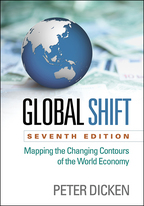Global Shift
Seventh Edition
Mapping the Changing Contours of the World Economy
Peter Dicken
The end of the world as we knew it?
Conflicting perspectives on ‘globalization’
Grounding ‘globalization’: geography really does matter
I. The Changing Contours of the Global Economy
2. The Centre of Gravity Shifts: Transforming the Geographies of the Global Economy 
The importance of taking a long view: the imprint of past geographies
Roller-coasters and interconnections
Global shifts: the changing contours of the global economic map
The centre of gravity has shifted
II. Processes of Global Shift
3. Tangled Webs: Unravelling Complexity in the Global Economy
Connections, connections
Institutional macro-structures of the global economy
Global production network PNs
Even in a globalizing world, economic activities are geographically localized
Networks of networks
4. Technological Change: ‘Gales of Creative Destruction’
Technology and economic transformation
Processes of technological change: an evolutionary perspective
Time–space shrinking technologies
Technological innovations in products, production systems and organizational forms
Geographies of innovation
5. Transnational Corporations: The Primary ‘Movers and Shapers’ of the Global Economy
The myth of the global corporation
Why firms transnationalize
How firms transnationalize
TNCs as ‘networks within networks’
Configuring the TNCs’ internal networks
TNCs within networks of externalized relationships
Perpetual change: reshaping TNCs’ internal and external networks
6. The State Really Does Matter
‘The state is dead’ – oh no it isn’t!
States as containers
States as regulators
States as collaborators
III. Winning and Losing in the Global Economy
7. The Uneasy Relationship Between Transnational Corporations and States: Dynamics of Conflict and Collaboration
The ties that bind
Bargaining processes between TNCs and states
8. ‘Capturing Value’ Within Global Production Networks
Placing places in GPNs
Creating, enhancing and capturing value in GPNs
Upgrading (or downgrading) of local economies within GPNs
9. ‘Destroying Value’? Environmental Impacts of Global Production Networks
Production–distribution–consumption as a system of materials flows and balances
Disturbing the delicate balance of life on earth: damaging the earth’s atmosphere
Fouling the nest: creating, disposing and recycling waste
Used clothing
10. Winning and Losing: Where You Live Really Matters
Location matters
Incomes and poverty
Where will the jobs come from?
Over-dependence on a narrow economic base
Populations on the move
11. Making the World a Better Place
‘The best of all possible worlds’?
TNCs and corporate social responsibility
States and issues of global governance
A better world?
IV. The Picture in Different Sectors
12. ‘Making Holes in the Ground’: The Extractive Industries
Beginning at the beginning
Production circuits in the extractive industries
Global shifts in the extractive industries
Volatile demand
Technologies of exploring, extracting, refining, distributing
The centrality of state involvement in the extractive industries
Corporate strategies in the extractive industries
Resources, reserves and futures
13. ‘We Are What We Eat’: The Agro-food Industries
Transformation of the food economy: the ‘local’ becomes ‘global’
Agro-food production circuits
Global shifts in the high-value agro-food industries
Consumer choices – and consumer resistances
Transforming technologies in agro-food production
The role of the state
Corporate strategies in the agro-food industries
14. ‘Fabric-ating Fashion’: The Clothing Industries
A highly contentious industry
The clothing production circuit
Global shifts in the clothing industries
Changing patterns of consumption
Technology and production costs
The role of the state
Corporate strategies in the clothing industries
Regionalizing production networks in the clothing industries
15. ‘Wheels of Change’: The Automobile Industry
All change?
The automobile production circuit
Global shifts in automobile production and trade
Changing patterns of consumption
Where will the jobs come from?
Over-dependence on a narrow economic base
Populations on the move
16. ‘Making the World Go Round’: Advanced Business Services
The centrality of advanced business services
The structure of ABS
Dynamics of the markets for ABS
Technological innovation and ABS
The role of the state: regulation, deregulation, reregulation
Corporate strategies in ABS
Geographies of ABS
17. ‘Making the Connections, Moving the Goods’: Logistics and Distribution Services
Taking logistics and distribution for granted
The structure of logistics and distribution services
The dynamics of the market for logistics services
Technological innovation and logistics and distribution services
The role of the state: regulation and deregulation of logistics and distribution services
Corporate strategies in logistics and distribution services
Logistics ‘places’: key geographical nodes on the global logistics map



